The Silverstone ST30SF & ST45SF SFX Power Supply Review
by E. Fylladitakis on January 26, 2017 9:00 AM EST- Posted in
- Cases/Cooling/PSUs
- PSUs
- 80Plus Bronze
- SilverStone
- SFX
- ST30SF
- ST45SF
External Appearance
The ST30SF and the ST45SF are externally identical, with the only apparent physical difference being the sticker on the side of their chassis. Even when it comes to the cables and connectors, the ST45SF only has one extra 8/6-pin PCIE connector, hinting that SilverStone expects the ST45SF only to be used if the PSU has to power a modern gaming graphics card. The designer’s logic is sound, as the number of drives that can be installed inside a compact chassis that has been designed for SFX PSUs usually is very limited, leaving no other device to require substantial levels of power other than a powerful GPU.
The ST30SF and the ST45SF feature a simple steel chassis that has been sprayed with a typical matte black paint. It is a very smooth paint job but the paint is highly prone to fingermarks. SilverStone placed the sticker with the electrical specifications on the left side of the chassis and small stickers with the unit’s serial number, version, etc., on the right side of the chassis. You can easily tell if the units are the latest or an older version by just looking at their fans: the newer ST30SF V2.0 and the ST45SF V3.0 models have 92 mm fans that barely fit into the body of the PSU, the older versions were using smaller 80 mm fans.
The company logo is once again engraved at the top of the unit, a technique that SilverStone performs on most of their PSU products to date. Despite the very small size of the chassis, the designer managed to find room for a small on/off switch next to the AC cable receptacle. The front of the PSU is plain, with just a hole for the hardwired cables to come out from. The cable arrangement is typical for the price range of these units, with color-coded wires covered in black nylon sleeving.
Internal Design
Whereas the ST30SF and the ST45SF externally are practically twins, there are significant differences on the inside of the units, which was to be expected considering that the ST45SF has 50% greater power output over the ST30SF. The first slight difference is their fan. Both of the simple black 92 mm low profile fans are supplied by Globe and are of the same series, but they are different models, with the ST30SF having a S0921512M and the ST45SF having a S0921512H installed. These fans have a “DURO” bearing engine, which is an enhanced version of a sleeve bearing that has been engineered for longevity. Their difference is that they have different speed ratings, with the former having a maximum speed of 2500 RPM and the latter of 3000 RPM.
A quick look on the inside reveals that both units share the same OEM and are based on the same platform, however there are great differences on the sizing of their components. Regardless of the electronic component sizes, it is worthwhile to mention that the main heatsinks remain identical, hinting that the extra cooling required to dissipate the higher energy losses of the ST45SF will be coming from its more powerful cooling fan. High Power is the OEM behind these two PSUs, a company mostly reputable for their balanced performance-to-cost designs.
The core design of the ST30SF/ST45SF is relatively simple technologically, with the designer obviously striving to deliver reliable, high quality power without caring about maximizing the product’s efficiency. Both units share the same components up to the input conversion bridge, with a filtering stage consisting of four Y capacitors, two X capacitors and two filtering inductors. The only difference here virtually is that the input conversion bridge of the 450W version has its own heatsink whereas the bridge in the 300W version has no heatsink at all.
SilverStone ST30SF Internal View
From here on, the design of both units remains the same but the size of the electronic components, both active and passive ones, differs greatly. The most apparent difference is the primary APFC capacitor, with a 180μF/400V capacitor in the ST30SF and a nearly a twice as large 330μF/400V capacitor in the ST45SF. Both are supplied by Japanese companies, Nichicon and Nippon Chemi-Con respectively. The smaller electrolytic capacitors in both units are supplied either by Nippon Chemi-Con or by Teapo, which is a good quality selection of products for cost-efficient PSUs.
SilverStone ST45SF Internal View
Two transistors on the primary side of the transformer form an asymmetric half-bridge inversion stage and four transistors on the secondary side form the synchronous rectifier for the 12V output. The 3.3V and 5V outputs are generated by DC-to-DC circuits found on the small vertical PCB. Despite the presence of the DC-to-DC conversion circuits and the synchronous rectifier, these units only reached up to an 80Plus Bronze certification, hinting that we might be dealing with high internal temperatures at higher outputs.


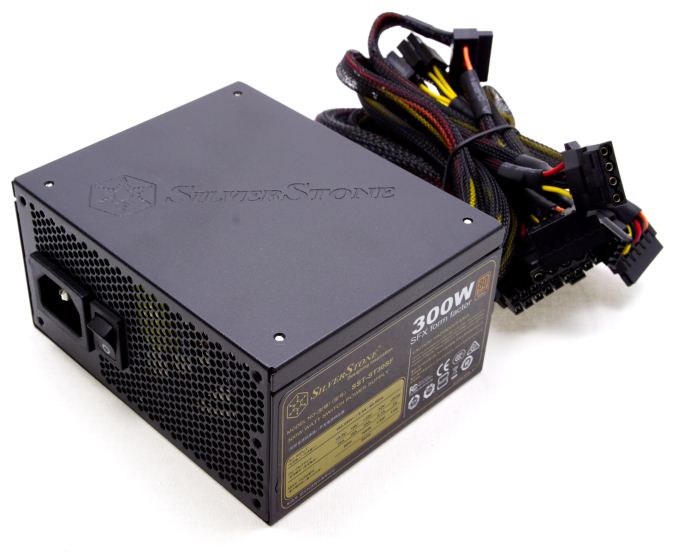
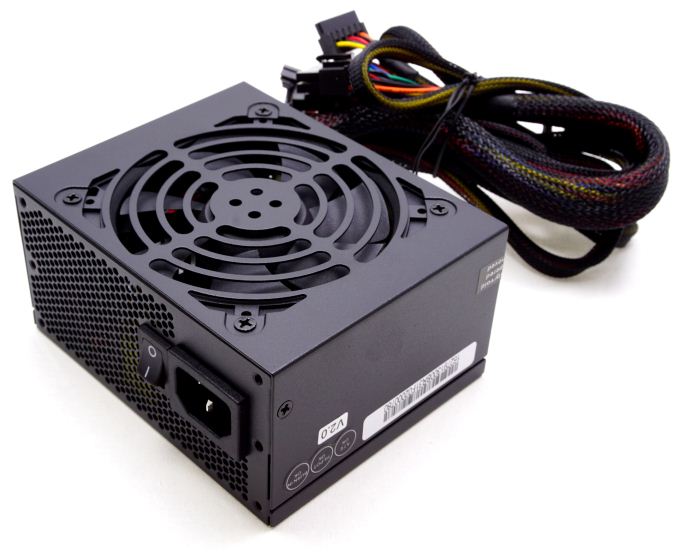
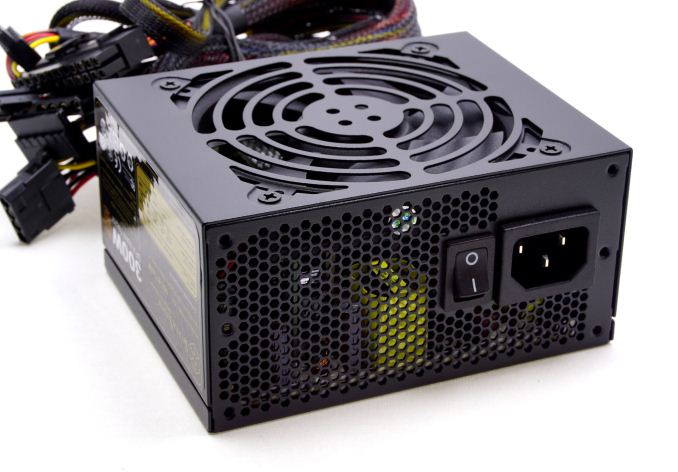
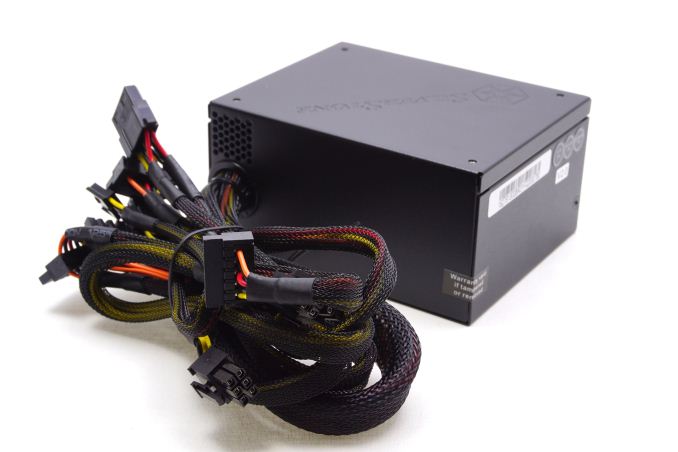
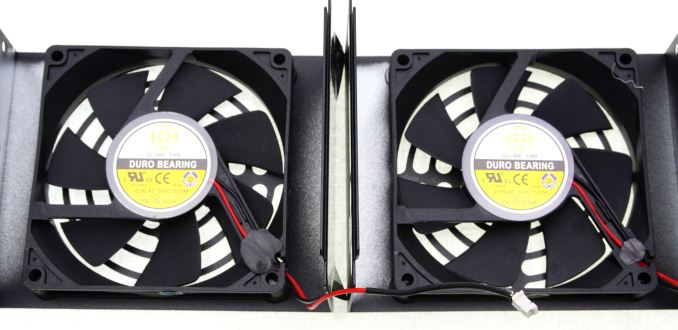
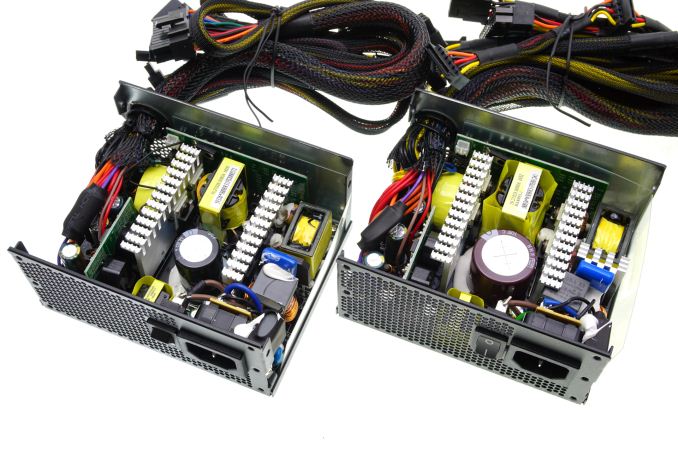
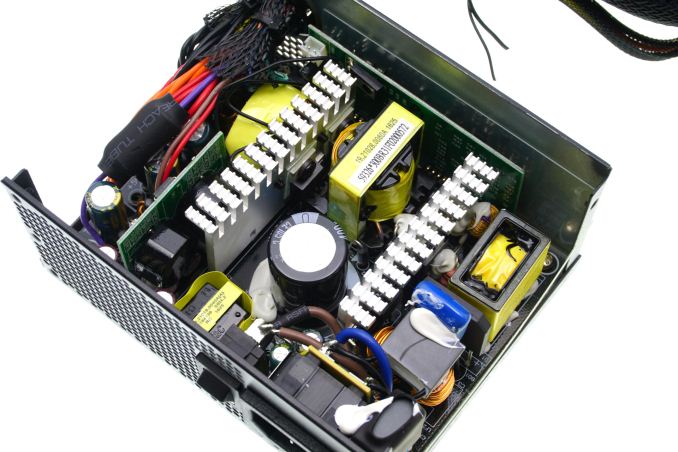


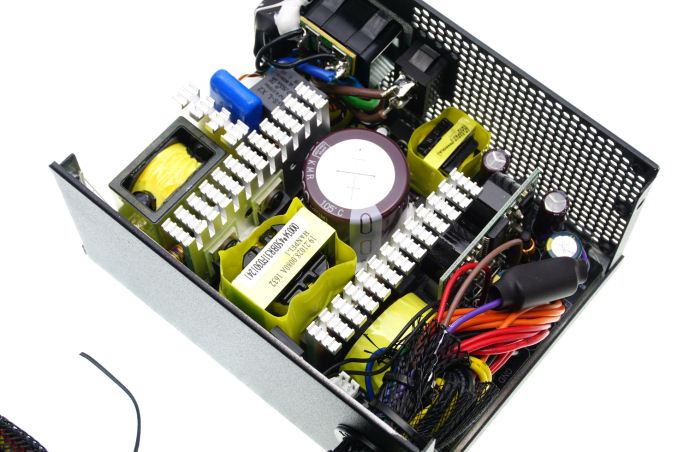








30 Comments
View All Comments
wolfemane - Thursday, January 26, 2017 - link
We are at a good point in power consumption where 550w and up aren't needed for standard builds. I'm running an i5-6600k oc'ed to 4.5ghz paired with a gtx 1080 on an asus mitx pro gaming board. M.2 os drive, couple mid range ssds for storage, and your basic 16gb ddr4-3200. At the wall, under load I'm barely drawing 400w. Currently using the 450w that comes with the Node 202.takeship - Friday, January 27, 2017 - link
Second to this. I purchased one of these Silverstone 450's a whopping 3y ago (v2 at the time) for a mITX Haswell i5 build with a GTX 660 (ncase m1). At load the system never topped 350w (according to HWMonitor), but it was more than enough (esp with the 80cm fan) and left a good bit of room to upgrade to something newer in the future. 8pin PCIe connectors are amazing for future proofing.takeship - Friday, January 27, 2017 - link
Still running without issue as well, for whatever the data value of my own anecdote is.NZLion - Tuesday, January 31, 2017 - link
The system I have running on a 600W SFX PSU is an ITX box with i7 6850K, 32GB DDR4 3000, Titan X Pascal, and 2TB Samsung 960 Pro M.2I haven't measured the load at the wall, but according to an online calculator (Outervision) I am likely using about 520W
zodiacfml - Friday, January 27, 2017 - link
300W is plenty these days. Thanks for the review. I am interested in such PSUs. I miss building PCs again, but now, I want the challenge of compact ones.Zan Lynx - Sunday, January 29, 2017 - link
That entirely depends on what you are building. A top end Intel CPU at full load can burn 140W plus the motherboard at 30W. Add a high end GPU at full load for 250W and you're at 420W already. Spinning hard drives idle at about 5W but during power-up they use up to 35W to spin up. There's been many a home-server builder with a broken build because their 8 drive system didn't have enough watts. NVMe SSDs use a lot of power during writes, the Intel models use up to 30W.Ascaris - Saturday, January 28, 2017 - link
I considered PSU reviews very carefully before I bought my current one. I find them extremely useful!thomasg - Sunday, January 29, 2017 - link
I, too, do appreciate such reviews, as they are actually useful for me a lot of times.Others should consider, that they might me more useful to them than they think, because more often than not such PSUs are much more suitable to most builds than the high-end stuff people seem to think they want.
There clearly is a need for good low-powered PSUs for smaller builds, and there really is a heavy lack of such units.
Just 2 weeks ago a friend asked me for a recommendation for a small media-server build for a couple of hard-disks in a small case, and I really had a hard time recommending anything with a practical power envelope.
It's really absurd that people think the widely available oversized PSUs are ever useful, as there is only a tiny tiny fraction of builds that can utilize them to more than 50% load.
A 600W PSU in a small SFX case seems ridiculous, as it is extremely unlikely that anyone will be using a >100W CPU and more than one 300W GPUs in those.
In this high-end setup even with reserves and some hard-disks you won't ever utilize more than 500W on the 12V rails. A 600W PSU will typically provide at least 550W on the 12V rails.
My rule of thumb for builds is to reach 80% load on 12V for hardware you're actually going to use, and if possible 20% load at typical low-power use (achieving 20% on idle would be ideal, but is impractical).
My dated Phenom II X6 setup is using a 550W GPU.
This is the X6 running at 4 GHz with slight voltage increase (max. 150W), a HD7970 (max. 300W), Chipset 15W, Storage 30W, 3 180mm fans (15W). Combined max. 510W.
Considering some of the power draw is not on the 12V rails, a PSU with 550W on 12V is plenty with some reserves.
This is an old platform with very high-draw components, that just aren't typical anymore.
So let's see what we can do with a 300W SFX PSU (obviously this will be no ultra-high-end overclocking system, that's simply not the purpose):
i5 65W, GTX 1070 150W, SSD+2*2,5" disks 20W, Chipset+RAM+Controllers 30W = 265W.
The 300W PSU can handle this easily with reserves.
Anyway, thanks for the review, I'm sure I will take these units into consideration for upcoming builds.
none12345 - Monday, January 30, 2017 - link
I wouldnt load a 450 watt power supply with 400 watt, 90% load will havea pretty short service life. Assuming you game a lot. Personally i shoot for ~80% load on electronics, it seems to make them last a hell of a lot longer. As well as power supplies being more efficient at ~80% load then ~90%.If i knew i would have a 400 watt load when gaming i would buy either a 500, or 550 watt, depending on price/specs. a 650 is too big, a 450 is too small in my opinion. You already have an approiately sized ps for that load.
thomasg - Wednesday, February 1, 2017 - link
As I said, 80% is the number to go for, we're not disagreeing.However, I'd argue, that you shouldn't be too conservative with your reserves, as actual usage will almost always be lower than the theoretical maximum.
Even with games using your hardware to the fullest extent, you won't ever draw maximum power for the components.
Your CPU will never draw maximum current outside of specifically designed synthetic benchmarks. Neither will your GPU. If you get to full load in a real world scenario it will unlikely last for more than a second at a time.
As this review shows, a reasonable quality PSU will handle even 100% load over a extended period of time without too much efficiency loss, so no reason to be overly cautious.
Gaming will practically never get you to continuous maximum power usage of your main components.
That said, different usage demands different configurations, so if you're building a render node, feel free to oversize a little.
TLDR;
Just don't overdo it. Pick the suiting hardware for the job, just as you do with other components. Oversizing too much will cost you doubly.